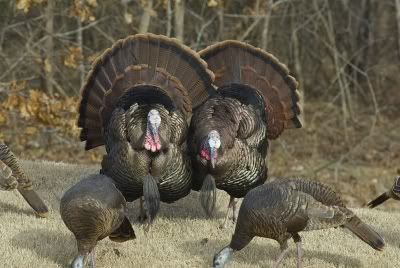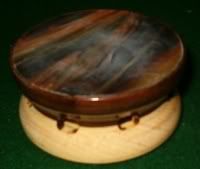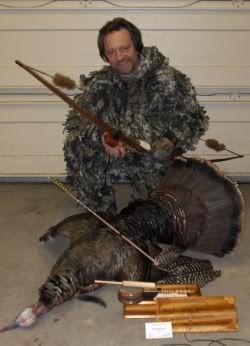As this years spring turkey season come to an end I thought it would be fitting to show you all a video of an exiting hunt from South Georgia. For those of you lucky enough to harvest a bird you can relive the excitement again by watching this video. For those of you, like me that went home with unfilled tags this video keeps the fever going.
Enjoy.
Tags: Wild Turkey, Hunting, YouTube, Turkey Hunting Video
Saturday, May 19, 2007
Saturday, May 12, 2007
Late Season Turkey Hunting Tips
 Turkey hunting season is coming to an end in a few days. The hunters that have not filled their tags yet ask in desperation for last chance tips on forums like SHS hunting Chat Forum and Jesse’s Hunting and Outdoors. If my email is any indication then there are quite a few of them.
Turkey hunting season is coming to an end in a few days. The hunters that have not filled their tags yet ask in desperation for last chance tips on forums like SHS hunting Chat Forum and Jesse’s Hunting and Outdoors. If my email is any indication then there are quite a few of them.This late in the season there are three categories of hunters.
The happy hunter: he has scored early and is now happily telling his tale over and over again.
The disillusioned hunter: like all of us he started out with high hopes of getting a tom, but as the season’s end comes closer he gives up. His favorite excuse usually is: “I hunted hard all these days and didn’t get a turkey- a few more days won’t change that”.
Then there is the determined hunter: he will not give up no matter what. His theme is: “It ain’t over till it’s over!”.
It is often the last category of hunters that close the season with a turkey in the freezer. Lets face it, you can’t kill a turkey if you sit at home contemplating the bad luck you’re having so far. So get out there and hunt till the last day. With a little change in strategy and some last ditch tactics you still have a more than an average chance at walking out of the woods with a turkey slung over your shoulder.
Here are some of the tactics that I use when there are only a few days left in the hunting season.
Late season turkeys are the smart birds. The dumb ones are in the freezer. These turkeys are a true challenge to hunt. You have to be a skillful caller and keep it simple. Forget the usual set ups and change your tactics to get you directly on top of the traveling toms. The birds you hunt now have heard just about every call from the good to the bad and the ugly. These turkeys have learned that calling means trouble and thus they shut up. It is possible that a gobbler will come in to your calls but he will not answer you. Instead, he will sneak along quietly, using available cover, towards you. These birds will usually hang up well out of shotgun range and watch for the slightest movement. If the tom does not see a hen where he expects to see one, he will slip away the same way he came in. To be successful with these paranoid, call-shy birds the set up becomes even more critical than at any other time during the season.
Despite all the challenges the later part of the spring turkey season is still one of my favorite times to be in the woods and chase a gobbler or two. I have the woods to myself and I do not have to get up so early to be in the hunting area at the crack of dawn. I am also more relaxed since my expectations are not as high as they where at the beginning. At this time of the season I am not after a boss tom; any turkey will fit the bill provided it is a legal bird.
I share the opinion of many other experienced turkey hunters that in the late season turkeys become call-shy. Especially in areas where there has been a lot of hunting pressure. So I keep my calls mostly in the pocket and instead spend more time scouting the area and trying to pattern a tom’s movement. I try to find the roosting tree and the strutting zones and from there figure out the gobbler’s travel path and time of day he travels. Then, the next day I set up as close to the travel path as possible, preferably within shotgun range, ambushing the bird when he walks past me. The best set ups for this tactic are where the turkey has to walk around a corner or over a hill. Anywhere where the bird cannot see me from a long way. For some hunters not seeing a turkey until he is in shooting range is a bit frustrating. But lets face it: If you can see the tom coming from a mile away then he will very likely see you too. Add to this the fact that a gobbler is always looking for a hen and at this time of the season has become very cautious- picking the surrounding terrain apart with his binocular like eyes for unusual movement-the you can understand why I set up where a tom cannot see me until it is to late for him.
Another tactic I sometimes employ is to be in the woods at around 9 am. By that time most other turkey hunters have left or are on their way out. Where legal also consider hunting in the afternoon. These are the times when the turkeys begin to relax and resume their normal activity with less paranoia and alertness. I try to get to a high point where I can observe a lot of territory below me with my binoculars. If I spot a tom I watch what route he takes. Then I try to move toward him, using the terrain to move unseen ahead of the tom and intercept him. This trick has worked for me often enough to give me confidence. If this tactic sounds familiar to you from elk hunting then you’re right, I borrowed this elk hunting tactic and modified it a bit for turkey hunting. It may sound strange for some of you but turkey and elk hunting are very similar with the difference that a turkey is much smaller than an elk of course.
If all else fails I move to a rather desperate last-ditch effort by employing a tactic that is very successful in the fall turkey season. Breaking up a flock of turkeys is not something you see often in the spring season, but can work well too. I admit that this is a rather off the wall tactic for spring turkeys. But hey, what do you have to lose when the clock is working against you? There are two ways to bust a turkey flock. Either you go right at dawn to the roosting tree and chase the birds out of the tree or the other method is to scatter a flock in the field. When you bust a flock the plan is to separate the tom from the hens. Watch where the tom is flying to and then follow him from a safe distance. The tom quickly will get lonely and starts to gobble to assemble the hens.
Try to be near the tom before a real hen is. Set up close to him and then give him some sweet hen talk; gentle yelps mixed with purrs and kee-kee runs. Kee-kee runs are associated with fall hunting but can work very well in the spring too; these such calls soon will convince the tom that one or more of his lost hens are searching for him. He will quickly come toward the calls to meet up with the hens but that’s where you are waiting for him with your shotgun at the ready. One precaution with this tactic though: please do not use this strategy if you are certain that there are still other hunters in the area. It’s just not safe plus the other hunters could get upset at you for spoiling their chances.
There you have it. Don’t be disillusioned or frustrated because you didn’t score on a bird yet. There are still a few days left of the season, so you had better get up, take your gun and try some of these tips rather than sit at home and bemoan your bad luck. Remember, its not over until it is over. Good luck.
Tags: Turkey Hunting Tips, Hunting Tactics, Wild Turkey, Hunting, Turkey Calling Tips, Shotgun,
Heirloom Custom Turkey Calls Update
 Brian Warner of Heirloom Custom Turkey Calls was kind enough to provide me with the latest update on what’s happening in this still young company. It has been a very successful season so far for Heirloom. Brian tells me “Heirloom Turkey Calls are becoming pretty popular. To be honest, I cannot say how many I have sold but I know that it’s over 150.”
Brian Warner of Heirloom Custom Turkey Calls was kind enough to provide me with the latest update on what’s happening in this still young company. It has been a very successful season so far for Heirloom. Brian tells me “Heirloom Turkey Calls are becoming pretty popular. To be honest, I cannot say how many I have sold but I know that it’s over 150.”Knowing Brian Warner, a tireless searcher for improvements and new materials to create new and better turkey calls, I was not surprised to learn that he has come up with new calls. Heirloom’s newest call additions to their extensive line up are: The Wafer Call which is a slim-line glass friction call that easily fits in your shirt pocket but don’t be fooled by the small size. This call has the customarily big sound volume common to all Heirloom Calls. As reported in an earlier article about Heirloom calls, Brian’s secret to achieving sound volume is in the sound chamber. What he does with the sound chamber is Brian’s closely guarded secret that he shares with nobody, including his dedicated pro-staff members.
All the slate style friction calls are now delivered with two strikers, a wooden and carbon striker. Now that right there is customer service not offered by other call makers. The carbon striker is what makes a turkey call waterproof on rainy and misty days, which are often the best times to hunt turkeys. Also a newer call in the lineup is the “Pass it On” wooden box friction call. And then there is still Brian Warner’s unique service of customized calls. These calls make beautiful presents for a friend, family member, or to honor a very special turkey trophy. Simply choose a picture of a special person or feather of a trophy turkey and send it to Brian and he will work it into the surface of the call. This service only works with glass calls.
Avid pro turkey hunter Dr. Zane Cofield who has been fortunate enough to field-test some of the Heirloom Calls expresses how well Heirloom Custom Turkey Calls worked for him. “I am winding down this turkey season having hunted Florida, Alabama, South Carolina, North Carolina, Virginia, and my home State, New York. I cannot stress enough the advantage of having professionally made calls; production calls are a dime a dozen and with the calling and hunting pressure we have today, especially on public lands, a good custom-made call or two can make a world of difference.”
 This spring season Dr. Coefield exclusively used The Double Barrel Call, Brian’s newest creation. This is a call that, as the name suggests, can be used on both sides. Each side has a different tone quality. The pots are made from different woods to achieve a different sound quality and appearance. The surface is made of glass and/or slate. As of this writing Brian is experimenting with copper surfaces. He says, “Copper has been chosen as the preferred metal surface due to its sound qualities. For generations bells were made from copper for that very reason.”
This spring season Dr. Coefield exclusively used The Double Barrel Call, Brian’s newest creation. This is a call that, as the name suggests, can be used on both sides. Each side has a different tone quality. The pots are made from different woods to achieve a different sound quality and appearance. The surface is made of glass and/or slate. As of this writing Brian is experimenting with copper surfaces. He says, “Copper has been chosen as the preferred metal surface due to its sound qualities. For generations bells were made from copper for that very reason.” Dr. Coefield’s spring season turkey harvest look impressive. He called and shot 13 gobblers with a shotgun and traditional bow in 6 different states. He credits part of his success directly to the Heirloom Custom Turkey Calls. “My grateful thanks are extended to Brian Warner for making a big difference in my turkey seasons. If you have not seen his calls, look for them.”
Dr. Coefield’s spring season turkey harvest look impressive. He called and shot 13 gobblers with a shotgun and traditional bow in 6 different states. He credits part of his success directly to the Heirloom Custom Turkey Calls. “My grateful thanks are extended to Brian Warner for making a big difference in my turkey seasons. If you have not seen his calls, look for them.” Producing new calls and enjoying a successful first business year with over 150 calls sold during the spring turkey season alone and having a high profile turkey hunter crediting his success to Heirloom calls are not the only good news. It seems that the professional hunting sources are catching on to the calls too. Early this year Jim Ferguson, a noted outdoor personality and radio-show-host invited Brian for an interview on his Great American Outdoor Trails Radio show. Jim Ferguson was very impressed with the quality and looks of the Heirloom Custom Turkey Calls. Jim subsequently invited Brian to attend more shows and joined the Heirloom Pro-Staff Team. The Great American Outdoor Trails Radio show is a nationally syndicated program with over two million regular listeners nationwide.
Producing new calls and enjoying a successful first business year with over 150 calls sold during the spring turkey season alone and having a high profile turkey hunter crediting his success to Heirloom calls are not the only good news. It seems that the professional hunting sources are catching on to the calls too. Early this year Jim Ferguson, a noted outdoor personality and radio-show-host invited Brian for an interview on his Great American Outdoor Trails Radio show. Jim Ferguson was very impressed with the quality and looks of the Heirloom Custom Turkey Calls. Jim subsequently invited Brian to attend more shows and joined the Heirloom Pro-Staff Team. The Great American Outdoor Trails Radio show is a nationally syndicated program with over two million regular listeners nationwide.As a proud Heirloom pro staff member of the first hour, I am extremely happy about our success. I am confidently looking forward to the future of Heirloom Custom Turkey Calls- a company that I can represent without any reservations. It has become rare in these hard, business driven times to find a company like Heirloom which still believes strongly in providing hunters with a quality product that will last forever, or to quote Dr. Coefield: “For men like me, there is a certain inner pleasure of catching forty pound salmon on a 90-year-old bamboo rod, fly-fishing for mahi-mahi off the coast of Bimini using a two-pound tippet, and calling in wily old turkeys with a call that is not only woods-worthy, but is also a piece of true art, made by a true artisan of the forest.”
Read more about Heirloom Turkey Calls here>
Tags: Turkey Calls, Turkey Hunting, Game Calls, Jim Ferguson, Radio Show, Heirloom Custom Turkey Calls , Brian Warner, Othmar Vohringer, Great American Outdoor Trails
Wednesday, May 09, 2007
Quebec Holds First Turkey Season
Hunters in Quebec had their first opportunity to pursue wild turkeys in La Belle Province (The Beautiful Province) in 2005 due to turkey migration from New York State into southern Quebec.
"The NWTF is thrilled that Quebec has opened a spring turkey season," said Dr. James Earl Kennamer, National Wild Turkey Federation senior vice president of conservation programs. "Turkey hunting will provide new opportunities for both hunters and local economies."
Quebec's experimental spring gobbler season, held April 25-30, resulted in 98 hunters taking 34 wild turkeys.
Unexpected hunter success during the first season convinced the Quebec Ministry of Wildlife and Parks to cancel their planned second season. The QMWP planned for hunters to take 30 birds during the two seasons. No dates have been set for future seasons.
"We selected five municipalities and assigned hunters to these areas," said Andre' Dicaire, QMWP biologist. "We knew we were sending hunters to good areas, and they were very successful."
More than 160 hunters applied for the chance to take one bearded bird during Quebec's turkey hunting season. The QMWP issued 98 turkey tags as recommended by their 2003 and 2004 wild turkey surveys that estimated there were 1,225 wild turkey gobblers in the area south of Montreal near the New York State border.
Tags: Wild Turkey, Turkey Hunt, Quebec, Canada, National Wild Turkey Federation
"The NWTF is thrilled that Quebec has opened a spring turkey season," said Dr. James Earl Kennamer, National Wild Turkey Federation senior vice president of conservation programs. "Turkey hunting will provide new opportunities for both hunters and local economies."
Quebec's experimental spring gobbler season, held April 25-30, resulted in 98 hunters taking 34 wild turkeys.
Unexpected hunter success during the first season convinced the Quebec Ministry of Wildlife and Parks to cancel their planned second season. The QMWP planned for hunters to take 30 birds during the two seasons. No dates have been set for future seasons.
"We selected five municipalities and assigned hunters to these areas," said Andre' Dicaire, QMWP biologist. "We knew we were sending hunters to good areas, and they were very successful."
More than 160 hunters applied for the chance to take one bearded bird during Quebec's turkey hunting season. The QMWP issued 98 turkey tags as recommended by their 2003 and 2004 wild turkey surveys that estimated there were 1,225 wild turkey gobblers in the area south of Montreal near the New York State border.
Tags: Wild Turkey, Turkey Hunt, Quebec, Canada, National Wild Turkey Federation
Subscribe to:
Posts (Atom)
